PPT商业展示
PPT如何在幻灯片中制作适合展示产品和服务的幻灯片
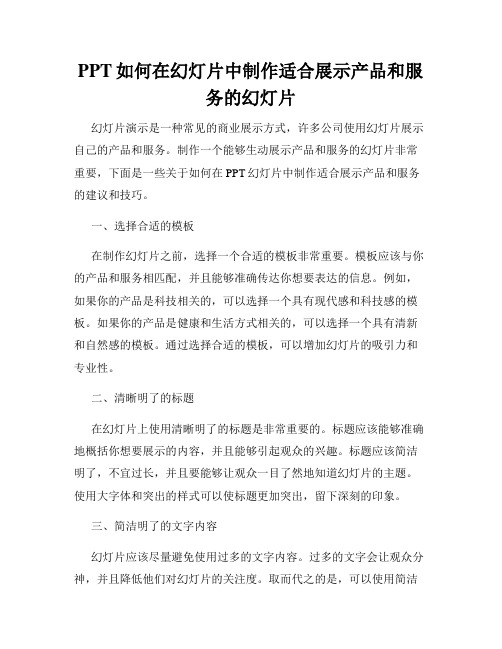
PPT如何在幻灯片中制作适合展示产品和服务的幻灯片幻灯片演示是一种常见的商业展示方式,许多公司使用幻灯片展示自己的产品和服务。
制作一个能够生动展示产品和服务的幻灯片非常重要,下面是一些关于如何在PPT幻灯片中制作适合展示产品和服务的建议和技巧。
一、选择合适的模板在制作幻灯片之前,选择一个合适的模板非常重要。
模板应该与你的产品和服务相匹配,并且能够准确传达你想要表达的信息。
例如,如果你的产品是科技相关的,可以选择一个具有现代感和科技感的模板。
如果你的产品是健康和生活方式相关的,可以选择一个具有清新和自然感的模板。
通过选择合适的模板,可以增加幻灯片的吸引力和专业性。
二、清晰明了的标题在幻灯片上使用清晰明了的标题是非常重要的。
标题应该能够准确地概括你想要展示的内容,并且能够引起观众的兴趣。
标题应该简洁明了,不宜过长,并且要能够让观众一目了然地知道幻灯片的主题。
使用大字体和突出的样式可以使标题更加突出,留下深刻的印象。
三、简洁明了的文字内容幻灯片应该尽量避免使用过多的文字内容。
过多的文字会让观众分神,并且降低他们对幻灯片的关注度。
取而代之的是,可以使用简洁明了的文字和短语来传达信息。
使用关键词和短语可以更好地吸引观众的注意力,并且使幻灯片更加易于理解。
在文字内容上,可以使用强调和重点标记来突出重要信息,提高观众的阅读效果。
四、有吸引力的视觉元素除了文字内容,视觉元素也是制作幻灯片时必不可少的一部分。
使用适当的图片、图表和图形可以增强幻灯片的吸引力,并且更好地展示产品和服务的特点和功能。
图片应该与产品和服务相匹配,并且具有高清晰度和良好的视觉效果。
图表和图形可以帮助观众更好地理解数据和信息,使幻灯片更具说服力和可读性。
五、配合适当的过渡效果和动画适当的过渡效果和动画可以使幻灯片更生动、有趣,并且能够吸引观众的注意力。
过渡效果可以在两个幻灯片之间切换时产生平滑的过渡效果,使整个演示更具连贯性。
动画可以将信息逐步展示或突出重点,使观众更好地理解和接受幻灯片中的内容。
精美微立体商务汇报PPT模板课件
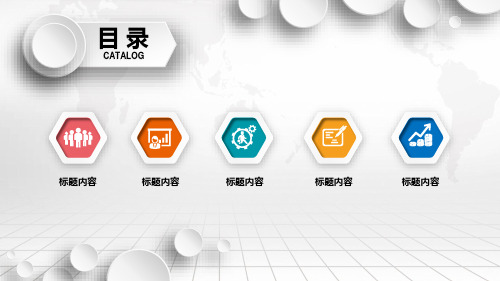
点击添加文字说明详情介绍点击添加文字说明详情介绍点击添加文字文字说明详情介绍
添加标题内容
添加标题
添加标题
添加标题
添加标题
添加标题
点击添加文字说明详情介绍
点击添加文字说明详情介绍
点击添加文字说明详情介绍
点击添加文字说明详情介绍
在此添加标题
单击添加详细文字说明,或复制文本黏贴自此右键只保留文字
添加标题内容
您的内容打在这里,或者通过复制您的文本后,在此框中选择粘贴,并选择只保留文字。您的内容打在这里,或者通过复制您的文本后,在此框中选择粘贴,并选择只保留文字。您的内容打在这里或者通过复制您的文本后,在此框中选择粘贴,并选择只保留文字。
标题内容
标题内容
标题内容
标题内容
标题内容
目 录
CATALOG
延迟符
第一部分标题文字内容
※ 添加内容
※ 添加内容
※ 添加内容
※ 添加内容
※ 添加内容
※ 添加内容
标题内容
添加标题内容
点击添加文字说明详情介绍点击添加文字说明详情介绍点击添加文字文字说明详情介绍
点击添加文字说明详情介绍点击添加文字说明详情介绍点击添加文字文字说明详情介绍
单击添加详细文字说明,或复制文本黏贴自此右键只保留文字
第五部分标题文字内容
※ 添加内容
※ 添加内容
※ 添加内容
※ 添加内容
※ 添加内容
※ 添加内容
标题内容
添加标题内容
添加标题
添加标题内容
01
02
03
04
05
在此添加标题
如何运用PowerPoint进行商业演示和销售展示
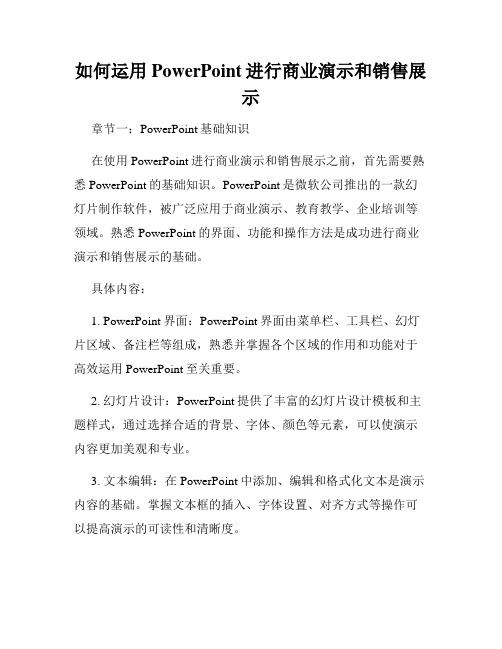
如何运用PowerPoint进行商业演示和销售展示章节一:PowerPoint基础知识在使用PowerPoint进行商业演示和销售展示之前,首先需要熟悉PowerPoint的基础知识。
PowerPoint是微软公司推出的一款幻灯片制作软件,被广泛应用于商业演示、教育教学、企业培训等领域。
熟悉PowerPoint的界面、功能和操作方法是成功进行商业演示和销售展示的基础。
具体内容:1. PowerPoint界面:PowerPoint界面由菜单栏、工具栏、幻灯片区域、备注栏等组成,熟悉并掌握各个区域的作用和功能对于高效运用PowerPoint至关重要。
2. 幻灯片设计:PowerPoint提供了丰富的幻灯片设计模板和主题样式,通过选择合适的背景、字体、颜色等元素,可以使演示内容更加美观和专业。
3. 文本编辑:在PowerPoint中添加、编辑和格式化文本是演示内容的基础。
掌握文本框的插入、字体设置、对齐方式等操作可以提高演示的可读性和清晰度。
4. 图片和图表插入:PowerPoint支持插入图片和图表,通过添加相关的图形元素来丰富演示内容,使之更具说服力和吸引力。
5. 幻灯片切换:PowerPoint提供多种切换方式,如淡入淡出、横向滚动、立体翻转等,将适当的幻灯片切换效果运用到商业演示和销售展示中,可以增加观众的注意力和参与感。
章节二:商业演示的策划与准备成功的商业演示离不开精心的策划和充分的准备。
在使用PowerPoint进行商业演示之前,需要明确演示的目标、受众、演示内容和讲述逻辑。
具体内容:1. 目标明确:商业演示的目标可以是推销产品、争取合作伙伴、应对投资者问题等。
在策划商业演示时,要明确目标并围绕目标进行内容设计和选材。
2. 受众分析:了解受众的需求、偏好和心理特点,有针对性地设计和呈现演示内容,提高演示的吸引力和说服力。
3. 内容编排:商业演示的内容应该有逻辑和层次感,确保信息的连贯性和完整性,同时避免过多的技术和专业术语,使非专业人士也能理解和接受。
商业演示PPT

TITLE GOSE HERE
TITLE GOSE HERE
TITLE GOSE HERE
我们的团队
MORE THEN
TEMPLATE
Click here to add you to the center of the narrative thought
MORE THAN TEMPLATE
MORE THAN TEMPLATE
MORE THEN TEMPLATE
点击此处添加文本信息。建议正文10号字,1.3倍字间距。 center of the narrative thought
MORE THEN TEMPLATE
点击此处添加文本信息。建议正文10号字,1.3倍字间距。 center of the narrative thought
点击此处添加文本信息。建议正文10号字,1.3倍字间距 the narrative thought
竞争对手分析
TITLE HERE
TITLE HERE
TITLE HERE
TITLE HERE
MORE THAN TEMPLATE MORE THAN TEMPLATE MORE THAN TEMPLATE MORE THAN TEMPLATE
MORE THAN TEMPLATE
点击此处添加文本信息。建议正文10号字 Center of the narrative thought
MORE THAN TEMPLATE
点击此处添加文本信息。建议正文10号字 Center of the narrative thought
投资亮点
TITLE GOSE HERE
MORE THAN TEMPLATE
MORE THAN TEMPLATE
产品展示商务PPT模板

PART THREE
ADD YOUR TITLE HERE
问题解决
PROJECT
PROJECT
PROJECT
PROJECT
MORE THAN TEMPLATE点击此处添加副标题
1
2
3
4
PROJECT
PROJECT
PROJECT
PROJECT
MORE THAN TEMPLATE点击此处添加副标题
点击此处添加标题
点击此处添加标题
点击此处添加标题
点击此处添加标题
MORE THAN TEMPLATE点击此处添加副标题
1
2
3
4
PROJECT 点击此处添加标题
PROJECT 点击此处添加标题
PROJECT 点击此处添加标题
PROJECT 点击此处添加标题
PROJECT
MORE THAN TEMPLATE点击此处添加副标题
2010
202X
202X
202X
202X
MORE THAN TEMPLATE点击此处添加副标题
PART FOUR
ADD YOUR TITLE HERE
产品展示
1
2
3
4
MORE THAN TEMMORE THAN TEMPLATE点击此处添加副标题
产品展示炫彩商务模板
PRESENTED BY kakappt
CONTENT
PART ONE
PART TWO
PART THREE
PART FOUR
问题场景 Click Here to Add Your Title
核心要求 Click Here to Add Your Title
商业展示类设计ppt课件
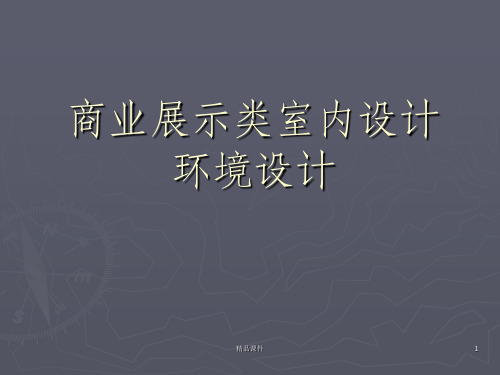
HERMES新加坡乌节路店
HERMES上海恒隆广场店
精品课件
12
2、构图与造型立意创新; 3、材质、色彩的精心配置; 4、入口与附属小品相结合。
的入
构口
图门
设把
置手
以
店
名
第
一
字
母
“
K”
精品课件
13
入口大门及地面饰以‘十’字形店标
橱窗
橱窗是商业建筑形象的重要标志,商店通过橱窗展示商品, 体现经营特色,橱窗又能起到室内外视觉环境沟通的“窗口”作用
精品课件
5
店面设计的要求和措施
(1)店面设计要求从城市环境整体,商业街区的景观出发, 以此作为构思的依据,并充分考虑地区特色、历史文脉、商 业文化等方面的要求。
商业演示PPT模版

极简主义设计, 极致简约风潮流 所向,通用设计, 完善兼容,打造 最实用,最具个 性的演示方案, 让你的演示杰出 特殊。
此处输入您的标题
LOREM IPSUM DOLOR SIT AMET CONSECTETUER LOREM
极简主义设计,极致简约风潮流 所向,通用设计,完善兼容。
A
极简主义设计,极致简约风潮流 所向,通用设计,完善兼容。
点击添加标题
极简主义设计,极致简约风潮流所向,通用设计,完善兼容,打造最实用,最具个性的演示方 案,让你的演示杰出特殊。极简主义设计,极致简约风潮流所向,通用设计,完善兼容,打造 最实用,最具个性的演示方案,让你的演示杰出特殊。极简主义设计,极致简约风潮流所向, 通用设计,完善兼容,打造最实用,最具个性的演示方案,让你的演示杰出特殊。
流所向,通用设计,完善兼容,
打造最实用,最具个性的演示 极简主义设计,极致简约风潮 方案。 流所向,通用设计,完善兼容,
打造最实用,最具个性的演示
方案。
点击添加标题
点击添加标题
点击添加标题
点击添加标题
添加 标题
此处输入您的标题
LOREM IPSUM DOLOR SIT AMET CONSECTETUER LOREM
4
风险管理
风险猜测/风险屏蔽/ 财务管理/后期完善/ 经营管理
此处输入您的标题
LOREM IPSUM DOLOR SIT AMET CONSECTETUER LOREM
极简主义设计, 极致简约风潮 流所向,通用 设计。
极简主义设计, 极致简约风潮 流所向,通用 设计。
极简主义设计, 极致简约风潮 流所向,通用 设计。
极简主义设计,极致简约 风潮流所向,通用设计, 完善兼容,打造最实用, 最具个性的演示方案,让 你的演示杰出特殊。
展示设计课件-1-商业展示PPT课件

86
87
88
89
90
91
课题作业
课题:
结合建筑平面图,作某一品牌专卖店室内外设计。
内容及要求:
平面图、顶棚图、主要立面、透视效果图、外立面(入口 设计、橱窗)。
A3图纸,功能布局合理、有鲜明的品牌形象。
进度安排:
第5周:绘制平面图、收集相关资料;
第6周:设计方法、方案草图;
第7周:确定方案、深入设计;
第8周:方案完成,交图。
92
商商业 业建建筑筑室室内内设设计 计
商业建筑室内设计,也称作商业空间设计,其实 质就是对产品与商业环境有机的结合。 为满足消费者不同的购物要求与目的,商业环境 通常可分为百货商场、专营店、自选商店和超市、 大型综合购物中心等不同经营性质和规模的空间。 商业建筑的主要组成部分包括营业厅、办公室、 库房及设备间等附属空间。
132
133
134
135
136
137
138
139
橱窗设计实例赏析
140
141
142
143
144
145
146
147
148
149
150
151
152
153
154
155
156
157
158
159
160
161
162
163
164
165
166
167
93
94
95
96
97
98
99
100
101
102
103
实例赏析
104
105
106
107
108
PowerPoint商业演示的策划和布局技巧

PowerPoint商业演示的策划和布局技巧在商业演示中,PowerPoint被广泛应用于传递信息、展示数据和推销产品。
为了确保演示的效果和吸引力,策划和布局是至关重要的。
本文将介绍一些关键的策划和布局技巧,帮助您打造出令人难忘的商业演示。
一、策划技巧1.明确目标:在开始设计演示之前,明确演示的目标非常重要。
确定您要传达的主要信息和演示的关键要点,并将它们贯穿于整个演示中。
确保每一张幻灯片都服务于您的目标,无论是通过图像、文字还是数据。
2.构建故事:一个好的商业演示应该具有引人入胜的叙事。
将您的内容安排成一个有始有终、有逻辑结构的故事,以吸引观众的兴趣并使他们参与其中。
使用引人注目的开局,清晰的主题句和令人印象深刻的结尾,帮助观众更好地理解和记住您的演示内容。
3.精简内容:避免在幻灯片上堆砌过多的文字和信息。
简洁扼要地表达每个要点,并使用图表、图像和图标来支持您的演示。
只保留关键信息,并用简单明了的语言来传达您的观点,这样可以让观众更轻松地理解和消化内容。
4.使用适当的图表和数据可视化工具:在商业演示中,数据通常是不可或缺的。
为了让数据更具说服力和可视化效果,使用适当的图表和数据可视化工具非常重要。
柱状图、折线图、饼图等都可以帮助观众更直观地理解和比较数据,同时也能增加演示的可视吸引力。
二、布局技巧1.选择合适的模板:在PowerPoint中,有很多预设模板可供选择。
选择一个与您的主题和目标相符的模板是一个很好的起点。
保持整个演示的风格一致,并使用幻灯片母版来统一字体、颜色和排版格式,以确保整个演示看起来整洁而专业。
2.重要信息突出:在幻灯片上,突出展示您的重要信息非常关键。
使用粗体、大号字体或不同的颜色来强调标题、关键词或要点。
这样做可以让观众更容易注意到这些重要信息,并更好地理解您的观点。
3.合理布局文本和图像:在安排幻灯片内容时,需要注意文本和图像之间的平衡。
避免将过多的文本置于一张幻灯片上,这会让观众感到厌烦。
商业展示设计PPT课件

§4 展示道具设计
一、展示道具的定义和作用 展示道具是在展示活动中使用的器具。它既是围护组合空间、称托陈
列展品、吊挂张贴、引导指示说明和保护展品等的设备,又是展示整体设 计中使观者直接感受的介面实体。
展示道具不但是为了更好突出展示效果,也是为了更好的展示陈列产品 所设计的。
二、展示道具设计和选用的原则是: 1、以定型的标准化、系列化为主,以特殊设计为辅; 2、以组合式、拆装式为主,以便于任意组合、变化,
62 总目
2、板:同台的水平状态不同,板可以以垂直状态呈现,板不 仅承载主要的图文信息,而且同墙壁相互转换,具有分隔空 间,塑造空间的作用。板还有尺度,形状和透与不透的变化。
63 总目
3、架:架的功能是双重的,一方面作为台与板的支撑骨架,另一 方面是一种独立的和灵活多变的展示道具,不仅可以悬置,挂置 展物,还可以架构形态,塑造空间。
间的构成等设计应同步展开。
50 总目
2、动线的设计方法 具有明确的顺序性、短而便捷 避免参观者形成相互对流或重复穿行的现象,还应防止漏看和重看 参观动线的方向是按视觉习惯由左至右按顺时针方向延展的 动线区域的划分应单纯明确。
51 总目
52
53
54
55
三、展示空间的平面规划
1、平面规划的要点 第一,以总体设计原则为前提,拟定总体平面设计方案。 第二,功能空间配置与展品的陈列,应按总的平面规划的次序以
买点广告设计;⑵饭店、餐馆、酒吧等展示设计;⑶宾馆展示设计。
12 总目
(三)、博物馆陈列设计 主要包括科技馆、历史博物馆、自然博物馆、民俗物产博物馆的陈列设 计。
(四)、演示空间设计 包括剧场影院、音乐歌舞厅、会议报告厅、礼堂、影视舞台、服装表演 等的空间环境设计。
商业演示图表商务PPT模板共16页
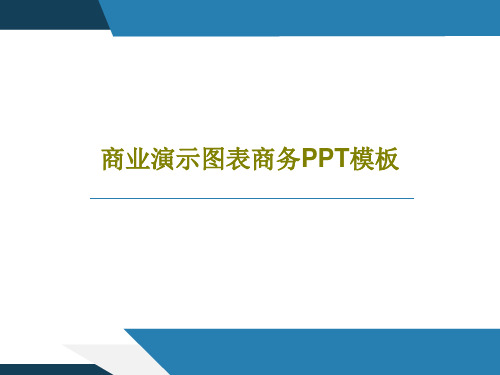
ቤተ መጻሕፍቲ ባይዱ 谢谢!
36、自己的鞋子,自己知道紧在哪里。——西班牙
37、我们唯一不会改正的缺点是软弱。——拉罗什福科
xiexie! 38、我这个人走得很慢,但是我从不后退。——亚伯拉罕·林肯
39、勿问成功的秘诀为何,且尽全力做你应该做的事吧。——美华纳
40、学而不思则罔,思而不学则殆。——孔子
商业演示图表商务PPT模板
1、纪律是管理关系的形式。——阿法 纳西耶 夫 2、改革如果不讲纪律,就难以成功。
3、道德行为训练,不是通过语言影响 ,而是 让儿童 练习良 好道德 行为, 克服懒 惰、轻 率、不 守纪律 、颓废 等不良 行为。 4、学校没有纪律便如磨房里没有水。 ——夸 美纽斯
5、教导儿童服从真理、服从集体,养 成儿童 自觉的 纪律性 ,这是 儿童道 德教育 最重要 的部分 。—— 陈鹤琴
《商业橱窗展示设计》课件

动态照明
运用LED灯等动态光源, 创造视觉冲击力,增强展 示效果。
道具和展品的选择与布置
展品选择
根据品牌定位和展示目的 ,选择具有代表性或特色 的展品。
道具设计
根据展品特点和展示风格 ,设计合适的道具,如展 台、展架、背景板等。
展品布置
合理安排展品的摆放位置 和角度,突出展品的优点 和特色,保持整体美观。
情感化设计
通过色彩、形状、灯光等元素,引发观众的情感 共鸣,增强展示的吸引力。
个性化定制
根据不同观众的需求和喜好,提供定制化的展示 内容,提高观众的参与度。
互动体验
设置互动环节,让观众参与其中,增强观众的沉 浸感和记忆点。
绿色环保与可持续发展
环保材料
使用可回收、可降解的环保材料,降低对环境的污染。
《商业橱窗展示设计》PPT 课件
目录
• 商业橱窗展示设计概述 • 商业橱窗展示设计的元素 • 商业橱窗展示设计的创意与表现 • 商业橱窗展示设计的实际应用与案例分析 • 商业橱窗展示设计的未来发展趋势
01
商业橱窗展示设计概述
商业橱窗展示设计的定义
商业橱窗展示设计是指通过创意和技巧,将商品、品牌信息 以及店铺形象以视觉化的方式呈现在橱窗内,吸引顾客的注 意力并激发其购买欲望的一种设计形式。
潮流元素
关注时尚潮流,将流行元素融 入设计中,提高橱窗的时尚感
。
品牌故事
通过展示品牌的历史、文化和 价值观,提升品牌形象和知名
度。
04
商业橱窗展示设计的实际应用与案 例分析
服装品牌的橱窗展示设计
总结词
突出品牌风格
详细描述
服装品牌的橱窗展示设计应突出品牌风格,通 过橱窗展示传达品牌形象和时尚理念。
用PowerPoint制作创业计划展现商业价值

用PowerPoint制作创业计划展现商业价值在当今商业竞争激烈的市场中,创业者们需要找到一种有效的方式来展现他们的商业计划和商业价值。
PowerPoint是一种广泛使用的软件工具,可以帮助创业者们以简洁、直观的方式传达他们的创业理念和商业潜力。
本文将介绍如何利用PowerPoint制作创业计划展现商业价值的方法和技巧。
一、选择适当的模板在开始制作创业计划之前,选择适当的PowerPoint模板非常重要。
一个精心选择的模板可以凸显您的商业理念,增加展示的吸引力。
您可以在PowerPoint软件中选择内置的模板或者自行下载其他专业的模板。
无论选择哪种方式,确保模板的风格和颜色与您的创业计划相匹配,并能够突出您的商业思路和价值。
二、明确创业目标在制作创业计划的过程中,明确创业目标非常重要。
这将帮助您在展示中清晰地阐述您的商业概念和商业价值。
确保在PowerPoint中以简洁明了的方式描述您的目标,并强调您的创新性和市场潜力。
您可以使用图表、数据和引人注目的图片来支持和体现您的创业目标。
三、关注商业模式商业模式是衡量商业价值的重要指标之一。
在您的创业计划中,将重点放在商业模式的描述和解释上。
使用PowerPoint制作图表和图形,以直观的方式向观众展示您的商业模式。
您可以使用漏斗图、饼图和柱状图等工具来比较数据和展示商业模式的可持续性。
确保图表和图形的排版整齐、美观,以增强观众的理解和兴趣。
四、强调市场分析市场分析是创业计划中不可或缺的一部分。
利用PowerPoint的文字和图表功能来展示您对市场的深入分析。
您可以使用文字描述市场规模、竞争对手和目标客户,并结合图表展示市场趋势和机会。
确保您的市场分析内容精确、清晰,并使用适当的颜色和字体以提高可读性。
五、展示商业策略商业策略是将商业理念转化为商业价值的重要步骤。
在您的PowerPoint展示中,阐述您的商业策略,并展示您的竞争优势。
使用幻灯片来表达您的核心理念和营销策略。
小清新简约时尚商务汇报商业路演PPT模板课件

输入标题
单击添加文本单击 添加文本单击添加 文本
单击添加标题文本
单击添加文本单击添加文本单 击添加文本
单击添加文本单击添加文本单 击添加文本
SO WT
单击添加文本单击添加文本单 击添加文本
单击添加文本单击添加文本单击 添加文本
单击添加标题文本
单击添加文本单 击添加文本单击 添加文本
单击添加文本单 击添加文本单击 添加文本
单击添加文本 单击添加文本 单击添加文本
单击添加文本 单击添加文本 单击添加文本
单击添加文本 单击添加文本 单击添加文本
单击添加文本 单击添加文本 单击添加文本
单击添加标题文本
单击添加文本单击添加文本单击添加文本 单击添加文本单击添加文本单击添加文本 单击添加文本单击添加文本单击添加文本 单击添加文本单击添加文本单击添加文本
简约时尚PPT商务模板
Click Enter Your Title Content Click Enter Your Title Content Click Enter Your Title Content
汇报人 某某某
目录
CONTENTS
此处添加名称
此处添加名称 此处添加名称
此处添加名称
添加标题
语言描述尽量简洁生动。
添 加 图 片
添 加 图 片
添 加 图 片
此处添加名称
此处添加详细文本描述,建议与 标题相关并符合整体语言风格,
语言描述尽量简洁生动。
添
加
图
此处添加名称
片
此处添加详细文本描述,建议与
标题相关并符合整体语言风格,
语言描述尽量简洁生动。
添加标题
在此处添加详细描述文本,尽量与标题文本语言风格相符合。
- 1、下载文档前请自行甄别文档内容的完整性,平台不提供额外的编辑、内容补充、找答案等附加服务。
- 2、"仅部分预览"的文档,不可在线预览部分如存在完整性等问题,可反馈申请退款(可完整预览的文档不适用该条件!)。
- 3、如文档侵犯您的权益,请联系客服反馈,我们会尽快为您处理(人工客服工作时间:9:00-18:30)。
Henry C. Co Technology and Operations Management, California Polytechnic and State University
Outline
1.
Supply Chain Management
The Beer Game –the Bullwhip Effect What Is SCM? Why Is SCM Important? E-Enabled SCM Solutions Collaborative Planning, Forecasting and Replenishment
“Supply Chain Management Primer,”
SCM, CRM, & ERP (Henry C. Co)
12
Features
1.
2.
3.
4.
Includes all activities and processes to supply a product or service to a final customer. Any number of companies can be linked in the supply chain. A customer can be a supplier to another customer so the total chain can have a number of supplier-customer relationships. Depending on the products and markets, the distribution system can be direct (supplier to customer) or indirect (involving distributors, warehouses, and retailers).
Lee and Billington
A supply chain is a network of facilities and distribution options that performs the functions of procurement of materials, transformation of these materials into intermediate and finished products, and the distribution of these finished products to customers. Ganeshan and Harrison
EDI and the Internet
The information available to supply chain partners, and the speed with which it is available, has the potential to radically reduce inventories and increase customer service.
SCM, CRM, & ERP (Henry C. Co)
9
What is the Supply Chain?
A network of autonomous or semi-autonomous business entities collectively responsible for procurement, manufacturing, and distribution activities associated with one or more families of related products. Jayashankar et al. A supply chain is a network of facilities that procure raw materials, transform them into intermediate goods and then final products, and deliver the products to customers through a distribution system.
SCM, CRM, & ERP (Henry C. Co) 8
The VMI Partnership
The supplier—usually the manufacturer but sometimes a reseller or distributor—makes the main inventory replenishment decisions for the consuming organization.
U.S. transportation & warehousing expense: ≈ 10% of GDP U.S. companies: 25% of corporate budgets on SCM
SCM, CRM, & ERP (Henry C. Co) 11
The supply chain is a series of links and shared processes that exist between suppliers and customers. Link and processes – all activities from the acquisition of raw materials to the delivery of finished goods to the the end consumer.
2.
Customer Relationship Management
What Is CRM? Why Is CRM Important? CRM Components and Technologies
3.
Enterprise Resources Planning
What Is ERP? Why ERP? The Major Players ERP Market Outlook
SCM, CRM, & ERP (Henry C. Co)
7
Vendor Managed Inventory
Wal-Mart and Procter & Gamble, Late 1980s Other companies in the United States, including Campbell Soup and Johnson & Johnson, and by European firms like Barilla (the pasta manufacturer). VMI became one of the key programs in the grocery industry’s pursuit of “efficient consumer response” and the garment industry’s “quick response.”
SCM, CRM, & ERP (Henry C. Co)
15
Information Flow
Products or services usually flow from supplier to to customer. Design and demand information usually flow from customer to supplier.
SCM, CRM, & ERP (Henry C. Co)
5
An Illustration of the Bullwhip Effect
Source: Johnson & Pike, 1999
SCM, CRM, & ERP (Henry C. Co) 6
Mitigating the Bullwhip Effect
“Supply Chain Management Primer,”
SCM, CRM, & ERP (Henry C. Co) 13
What is Supply Chain Management?
Management of flow of materials, information, and funds across the entire supply chain.
The supplier monitors the buyer’s inventory levels (physically or via electronic messaging) and makes periodic resupply decisions regarding order quantities, shipping, and timing. Transactions customarily initiated by the buyer (like purchase orders) are initiated by the supplier instead. The purchase order acknowledgment from the supplier may be the first indication that a transaction is taking place; an advance shipping notice informs the buyer of materials in transit.
Everyday low pricing eliminate forward buying of bulk orders Changes in pricing and trade promotions and channel initiatives, such as VMI, CPFR, continuous replenishment can significantly reduce demand variance. Postponement Etc.
